
Reveal 설문 보고서: 2023년 최고의 소프트웨어 개발 과제
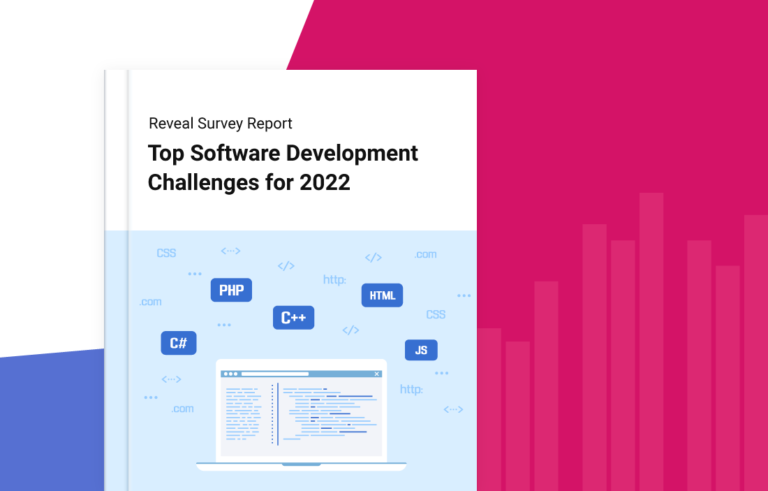
2023 Reveal 연례 소프트웨어 개발자 설문 조사에 따르면, 개발자 부족은 2년 연속으로 주요 과제로 남아 있습니다.
개발자 도구의 혁신에 발맞춰 워크로드 관리, 보안 위협 및 프로젝트 관리는 2023년의 또 다른 주요 고충입니다. 또한 설문 조사에서는 소프트웨어 개발자가 새로운 디지털 환경에서 커뮤니케이션 및 협업 도구로 계속 어려움을 겪고 있는 것으로 나타났습니다.
2022년에 개발자가 직면한 장애물을 파악하고 미래의 과제를 밝히기 위해 2,000명이 넘는 소프트웨어 개발자와 IT 전문가를 대상으로 설문 조사를 실시하여 가장 큰 문제점, 과제 및 성장 영역을 파악했습니다.
Reveal 설문 조사에서는 다음 사항을 조사했습니다.
- 업계가 소프트웨어 개발자의 부족을 해결하는 방법
- 가장 채우기 어려운 기술직
- 업계에서 원격 및 하이브리드 팀 내 커뮤니케이션/협업 문제를 해결하는 방법
- 임베디드 분석 및 비즈니스 인텔리전스의 급증하는 인기
- 2022년 모멘텀과 2023년 성장 계획
이 설문 조사 보고서는 소프트웨어 개발자가 2023년에 성공하기 위해 이러한 문제를 해결하고, 새로운 도구와 기술을 채택하고, 리소스를 배포하는 방법에 대한 주요 결과를 분석합니다.
계속 읽기
계속 읽으려면 양식을 작성하십시오.
중요한 발견들
2023년의 가장 큰 비즈니스 과제는 작년과 동일하게 적절한 기술을 갖춘 개발자를 모집하는 것입니다. 응답자의 3분의 1 이상(37.5%)은 2023년에도 숙련된 개발자를 찾는 데 계속 어려움을 겪을 것이라고 말했습니다.
기술 인재 부족은 줄어들 기미가 보이지 않으며 미국 노동부는 소프트웨어 엔지니어의 전 세계 부족이 2030년까지 8,520만 명에 달할 것으로 추정합니다. 인재 부족은 경쟁 및 혁신의 어려움, 높은 비용 및 수익 손실을 포함하여 기술 산업에 많은 영향을 미칩니다. 조직에서 인재 부족 문제를 해결하는 방법 중 하나는 로우 코드 도구를 비롯한 새로운 기술과 애플리케이션을 채택하여 개발자에 대한 요구를 낮추는 것입니다. 설문 조사는 또한 IT 산업에서 가장 수요가 많은 직업을 식별했습니다.
개발자 부족 외에도 설문 조사에 따르면 2023년의 다른 주요 비즈니스 과제는 직원 안전 유지(37.2%) 및 제한된 리소스(36.5%)입니다. 지난 3년 동안 근로자는 COVID-19 팬데믹, 경기 침체, 불안정한 작업 환경 등 예상치 못한 일련의 문제에 직면했으며 이로 인해 고용주는 근로자를 보호하기 위해 더 많은 조치를 취해야 합니다. 직원을 보호하기 위한 조치를 취하는 고용주는 특히 개발자 부족에 비추어 볼 때 직원을 유지할 가능성이 더 높습니다.
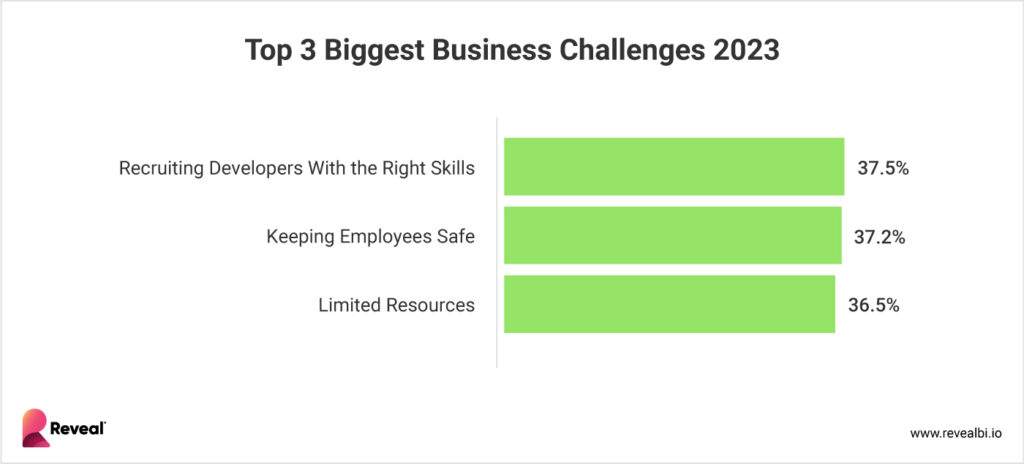
최고의 소프트웨어 개발 과제
가장 최근의 미국 노동 시장 데이터는 1969년 이후 가장 낮은 실업률을 보고했으며, 1월에만 517,000개의 일자리가 추가되었습니다. 2022년 미국 기반 기술 기업의 정리 해고 발표가 있는 가운데 기술 산업에서 가장 수요가 많은 일자리가 무엇인지 조사했습니다.
2023년에 가장 채우기 어려운 상위 3개 기술직은 DevOps 엔지니어(16.39%), 데이터 분석 개발자(16.27%) 및 IT 보안 엔지니어(13.4%)입니다.
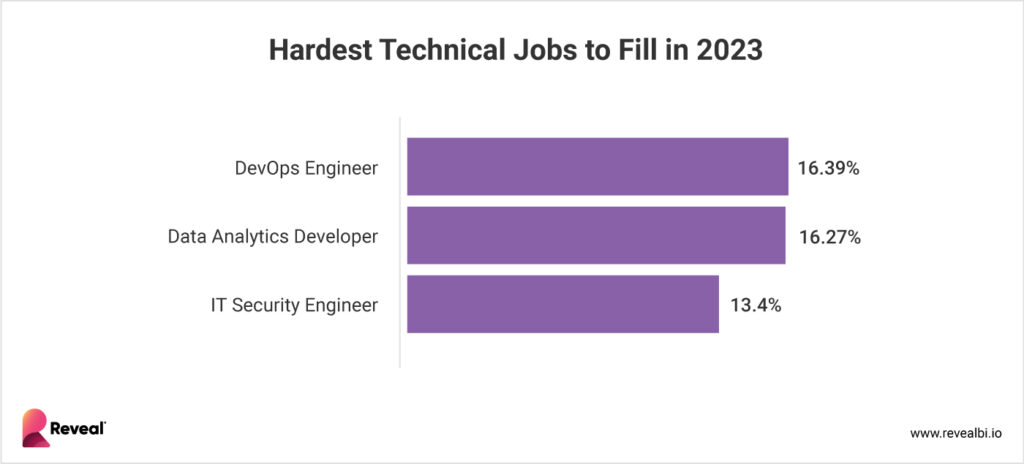
거의 모든 개발자(88.8%)가 디자이너 또는 디자인 팀과 함께 작업하지만 개발자 시간의 거의 절반(43.4%)이 앱 코딩에 사용됩니다. 숙련된 개발자 부족 문제는 조직의 3/4(76.8%)에서 로우 코드/노 코드 도구를 사용하여 해결되고 있습니다. App Builder와 같은 코드가 적거나 코드가 없는 도구는 디지털 제품 팀이 사전 코딩이 거의 또는 전혀 필요하지 않은 시각적 도구로 응용 프로그램을 만들 수 있도록 도와줍니다. 개발 팀은 배포 전에 응용 프로그램을 '마무리'하기만 하면 됩니다. 이 접근 방식은 화면 디자인, UX 흐름, 테마 및 브랜딩과 같은 영역에서 과도한 수작업 코딩의 필요성을 줄임으로써 개발자의 요구를 완화하는 데 도움이 되며 수동 HTML 및 CSS 조정의 필요성을 거의 제거할 수 있습니다.
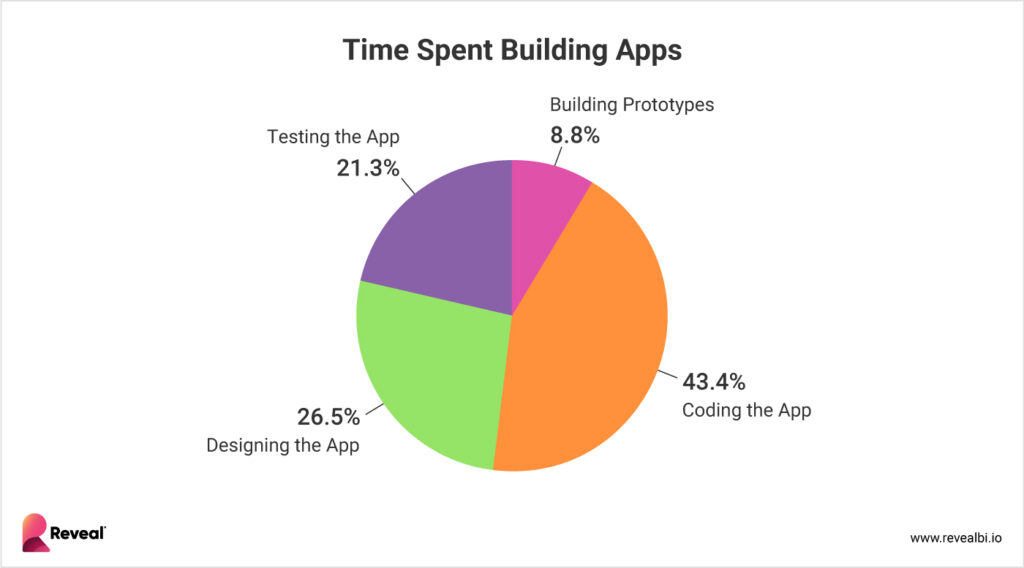
소프트웨어 개발자는 2023년에 프로젝트 관리 개선 (30%), 디자이너/개발자 협업 개선(30%), 시민 개발자를 위한 소프트웨어 사용(27%), 원격 직원 활용(25%), 데이터 카탈로그 /분석 카탈로그 통합(25%).
2023년 가장 큰 소프트웨어 개발 과제는 개발자 도구의 혁신(27.7%), 타사 통합의 어려움(26.70%), 워크로드 관리의 어려움(26.2%), 보안 위협(26.10%), 프로젝트 관리(26.10%) 및 고객의 너무 높은 기대(26%)를 따라잡지 못하는 것입니다.
이러한 프로젝트 관리 및 협업 과제 중 다수는 디지털 워크플레이스 생산성 도구로 극복할 수 있습니다. 예를 들어 Slingshot 원격 팀을 정렬하고 더 나은 업무 커뮤니케이션을 촉진하는 데 도움이 됩니다. 프로젝트 및 작업 관리, 콘텐츠 관리, 협업, 데이터 분석 및 데이터 카탈로그 기능을 갖춘 Slingshot 팀이 워크로드를 보다 지능적으로 관리하고, 마감일을 최신 상태로 유지하고, 확실한 사실에 뒷받침되는 보다 현명한 비즈니스 결정을 내릴 수 있도록 합니다.
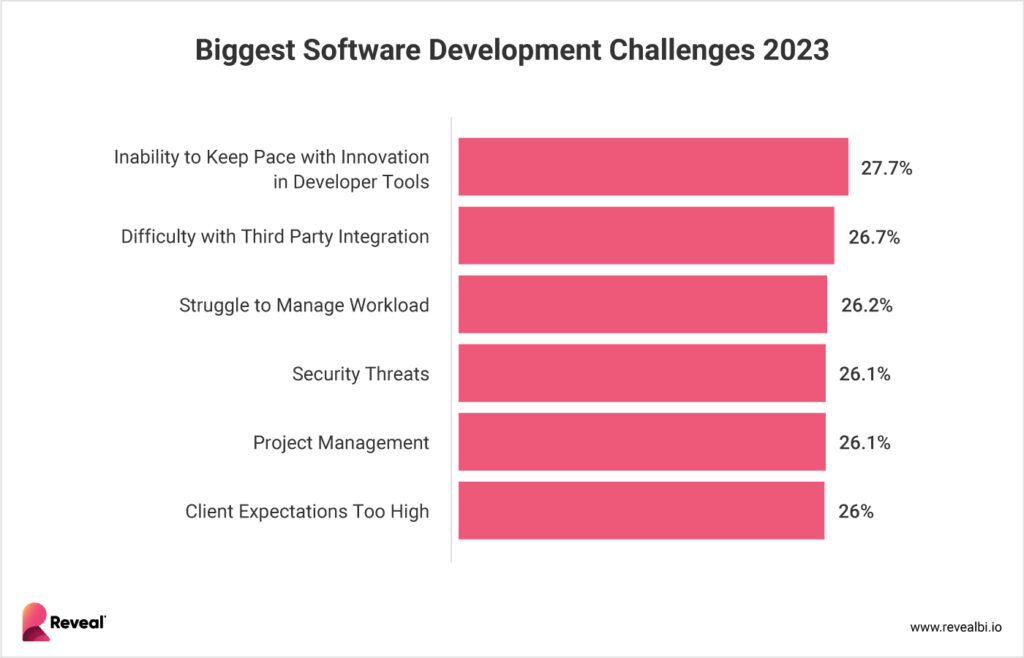
디지털 혁신을 통한 리소스 배포
이제 많은 조직이 원격/하이브리드 팀으로 이동하고 물리적 존재를 축소했기 때문에 2022년의 업무 복귀 문제는 대부분 해결되었으며 직원을 원격 근무로 전환하려는 노력이 23% 감소한 것으로 나타났습니다. 그러나 조직의 18.6%만이 완전히 현장에 있기 때문에 새로운 디지털 환경에서 팀원과의 의사소통 및 협업의 어려움은 여전히 남아 있습니다.
원격/하이브리드 작업 공간은 소프트웨어 개발자가 새로운 온라인 협업 도구를 설치하고 생산성을 개선할 방법을 모색함에 따라 수많은 문제를 야기했습니다. 응답자의 절반 이상(57.9%)이 출퇴근 시간 단축으로 인해 작업 프로젝트를 완료하는 데 더 많은 시간이 필요하다고 답한 반면, 10명 중 4명(42%)은 프로젝트를 추적하는 데 어려움을 겪고 있으며 3분의 1(31.9%)은 생산성이 떨어진다고 답했습니다. 하이브리드 환경. 위에서 언급한 바와 같이 올인원 디지털 작업 공간의 사용이 생산성을 높이고 결과를 개선하려는 조직에 큰 가치가 되는 곳입니다.
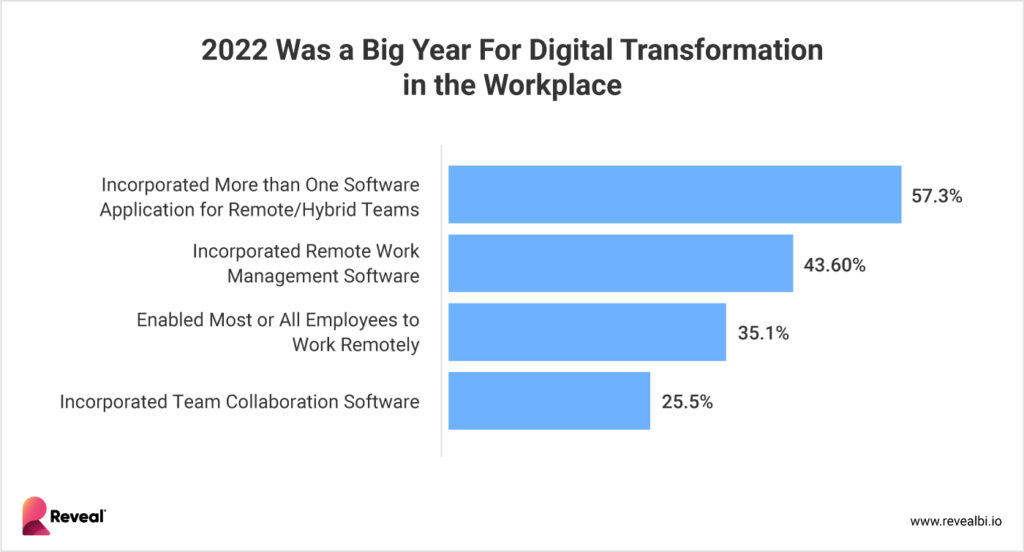
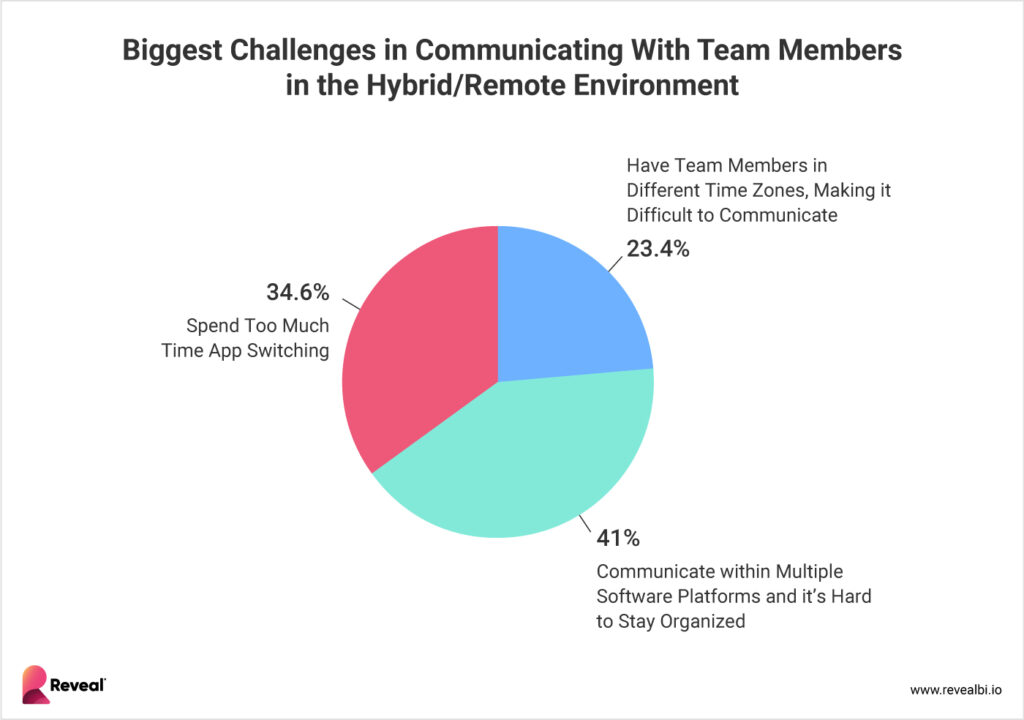
소프트웨어 개발자의 3분의 1은 최적의 생산성을 보장하는 최선의 방법을 찾기 위해 고군분투하면서 2022년에 원격/하이브리드 작업자를 위한 새로운 소프트웨어를 통합했습니다. 절반 이상(54.4%)이 모두가 협력하여 문제를 해결할 수 있는 하나의 도구를 사용하기를 원합니다. 또 다른 47.5%는 워크플로우와 프로세스를 자동화하고 싶어하고 43.7%는 수동 파일 공유를 없애는 것을 선호합니다.
임베디드 분석 여전히 증가하고 있습니다.
임베디드 분석 및 비즈니스 인텔리전스는 2022년에 소프트웨어 개발자 10명 중 8명(80.8%)이 이러한 분석 도구를 제품에 통합하여 인기가 계속 높아지고 있으며, 이는 2021년보다 3% 증가한 것입니다.
클라이언트용으로 개발된 앱에 포함된 분석 기능에 대한 수요도 2021년 30.8%에 비해 2022년에는 48%의 개발자가 클라이언트 앱에 분석 기능을 내장하면서 급증하고 있습니다. 그리고 소프트웨어 개발자의 74.9%는 2023년에는 비즈니스 인텔리전스에 대한 조직의 관심이 증가할 것으로 예상합니다.
많은 이점이 있지만 소프트웨어 개발자가 임베디드 분석을 사용하는 가장 큰 세 가지 이유는 다음과 같습니다.
- 고객 만족도 향상(32%)
- 경쟁 우위 확보(30.1%)
- 데이터 기반 의사 결정 (24.7%)
임베디드 분석은 최종 사용자가 데이터 분석 전문가의 도움 없이 통찰력을 발견하도록 돕는 것 외에도 다음과 같은 많은 다른 이점이 있습니다.
- 출시 시간 단축
- 상황별 분석
- 수익 성장
- 사용의 용이성
- 데이터 기밀성
고객이 소프트웨어에 내장된 분석 기능을 요구하는 주요 이유는 생산성 향상(41.6%), 판매/수익 증대(39.5%), 비즈니스 문제 이해(33%), 더 나은 비즈니스 의사 결정(31.8%)입니다.
2023년에는 점점 더 많은 조직이 내장형 분석 도구를 수용하게 될 것입니다. 왜냐하면 이러한 도구는 경쟁 우위와 비즈니스 성장을 달성하는 데 핵심이기 때문입니다. 다음은 2023년에 비즈니스 인텔리전스의 미래를 형성할 몇 가지 중요한 트렌드입니다.
- DaaS(Data-as-a-Service)– DaaS는 클라우드를 사용하여 네트워크 연결을 통해 데이터 통합, 처리, 저장 및/또는 분석 서비스를 제공하여 데이터 워크로드의 민첩성을 개선하고 통찰력을 얻는 시간을 단축하며 비즈니스 데이터의 안정성과 무결성을 높이는 데이터 관리 전략입니다.
- 데이터 청정실– 개인 정보 보호 규정을 준수하면서 데이터를 공유하는 것은 항상 기업의 과제였습니다. 그러나 데이터 클린룸은 이를 개선하기 위해 여기에 있습니다. 데이터 클린룸을 사용함으로써 이제 데이터를 효과적으로 관리하고, 식별하고, 개인 정보 보호 규칙에 따라 안전한 방식으로 공유할 수 있습니다.
- ESG–환경, 사회 및 거버넌스는 2023년에 기업이 조직의 환경 효율성 및 지속 가능성을 결정할 수 있도록 채택해야 하는 세 가지 핵심 데이터 분석 구성 요소입니다.
- AI– AI 및 기계 학습 알고리즘은 데이터 패브릭 기능, 지능형 조직 데이터 카탈로그, AI 기반 데이터 정리, 셀프 서비스 데이터 준비 등을 생성하거나 제공함으로써 사용자가 분석 및 데이터 관리와 상호 작용하는 방식을 개선합니다.
- 데이터 레이크하우스– 많은 기업이 이미 기술, 클라우드 플랫폼 및 디지털 시스템에 막대한 투자를 했습니다. 이러한 투자에 대해 더 높은 ROI를 얻으려면 이러한 조직은 데이터 레이크와 데이터 웨어하우스를 결합하여 추가 속도, 스토리지 및 운영 효율성을 제공하는 데이터 레이크하우스를 구성해야 합니다.
2022년 소프트웨어 산업의 성과
데이터에 따르면 소프트웨어 개발자의 수익 증가율은 2021년 25%에 비해 2022년에는 18.8%에 불과해 모멘텀이 약간 둔화되고 소프트웨어 개발자의 수익 성장이 감소한 것으로 나타났습니다. 그러나 소프트웨어 개발자는 2023년 해고 건수가 거의 10% 감소하고 자금 손실이 크게 감소했다고 보고했습니다.
새로운 프로젝트를 맡은 개발자의 비율은 2021년 36.22%에 비해 2022년에는 33.3%로 소폭 감소했습니다. 전년 대비 8% 하락한 4분의 1(25%)만이 새로운 시장으로 확장되었습니다. 제안 요청도 2022년에 감소하여 2021년에 비해 12% 감소했습니다.
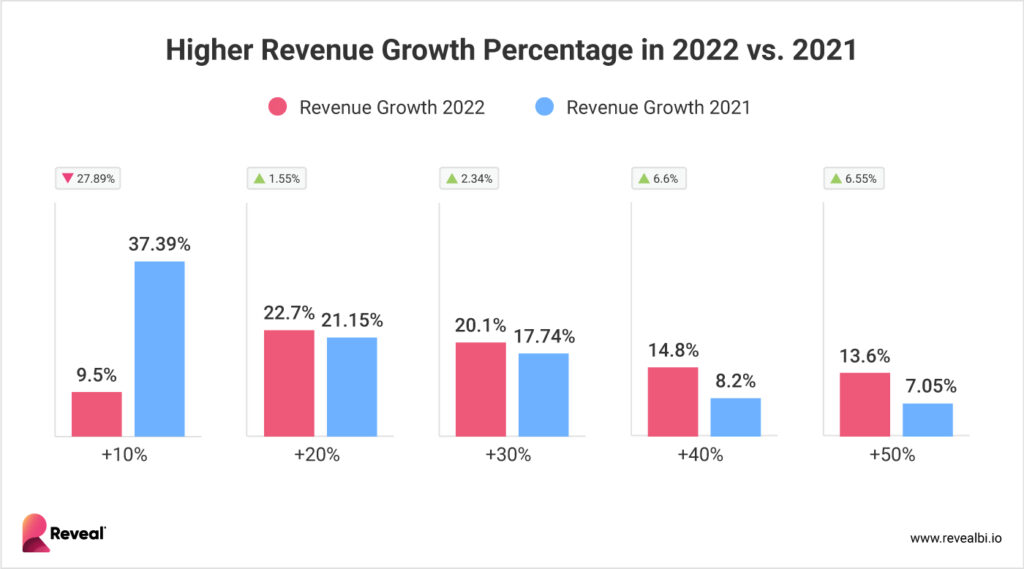
기술 회사는 대유행 기간 동안 빠르게 확장했으며 일부는 과잉 확장의 여파로 구조 조정과 허리띠를 졸라매고 있지만 디지털 혁신 이니셔티브는 소프트웨어 개발자에게 성장과 수익을 위한 새로운 기회를 제공합니다. 이러한 경기 둔화 속에서 기업은 IT 인프라와 애플리케이션에 지속적으로 투자하여 고객 경험과 디지털 혁신 이니셔티브를 개선할 것입니다.
소프트웨어 개발자가 2023년에 비즈니스를 성장시키는 방법
2022년 성장 결과는 다소 실망스러웠지만 소프트웨어 개발 산업은 2023년 성장에 대한 큰 계획을 가지고 있습니다.
2023년 소프트웨어 개발 산업의 확장 계획은 다음과 같습니다.
- 새로운 기술/애플리케이션 채택(37.90%)
- 새로운 시장으로 확장(35%)
- 신규 프로젝트 착수 (32.50%)
- 수익 증대(31.40%)
- 제안 요청 증가(31.40%)
새로운 기술/응용 프로그램을 채택하면 회사에 큰 수익 기회를 추가할 수 있습니다. 최소한 이러한 기술과 애플리케이션은 비용을 낮추고 비용을 절감합니다. 반면에 제품에 새로운 기능을 통합하면 제품의 가치가 향상되므로 가격을 높이거나 이러한 기능을 고객에게 상향 판매할 수 있는 특수 기능으로 제공할 수 있습니다.
예를 들어 자산 관리 소프트웨어가 있고 고객이 휴가용 임대 주택에 관한 데이터를 쉽게 분석할 수 있도록 지원하는 기능 제품군의 일부로 최근 BI 기능을 도입했다고 가정해 보겠습니다. 예를 들어 고객에게 매월 사용자당 $5를 청구한다고 가정해 보겠습니다. 해당 가격에 모든 자산 관리 기능을 포함하고 좌석 기반 가격 외에 고정 가격으로 분석 솔루션을 판매할 수 있습니다.
결론
소프트웨어 개발 산업은 비즈니스 세계를 디지털화하기 위해 경쟁하면서 숙련된 소프트웨어 개발 직책을 채우는 데 계속 어려움을 겪고 있습니다. 그러나 로우 코드/노 코드 도구는 인재 부족을 완화하는 데 도움이 됩니다. 또한 설문 조사에서는 업무 복귀 문제가 대부분 해결되었지만 업계는 특히 하이브리드 및 원격으로 작업하는 팀 내 커뮤니케이션 및 협업에서 실질적인 문제에 계속 직면하고 있음을 발견했습니다. 다행스럽게도 새로운 디지털 작업 공간 소프트웨어 플랫폼은 팀이 어디에 있든 관계없이 팀을 더 잘 연결하는 데 도움이 됩니다. 2022년은 모멘텀이 약간 둔화되었지만 2023년은 신기술 채택, 신규 시장 진출 및 매출 증가의 해가 될 것으로 예상됩니다.
기술 산업은 본질적으로 새로운 기술의 맹공격이 특히 하이브리드 작업장에서 새로운 혁신의 문을 열면서 상당한 변화와 발전을 계속 경험할 것입니다. 폭풍을 이겨내고자 하는 기술 회사는 새로운 도구와 기술에 보조를 맞춰야 합니다. 혁신은 더 많은 파괴를 의미하는 동시에 계속해서 발전할 수 있는 사람들에게 더 많은 기회를 제공합니다.
설문 조사 정보
2022년 12월부터 2023년 1월까지 2023년 1월까지 2000명 이상의 소프트웨어 개발자와 IT 전문가가 'Reveal 2023 설문조사 Infragistics 참여했습니다.
설문 조사나 내장형 분석 제품 Reveal에 대한 질문이 있으면 CaseyM@revealbi.io로 연락하세요. 기꺼이 도와드리고 질문에 답변해 드리겠습니다.
케이시 맥기건





